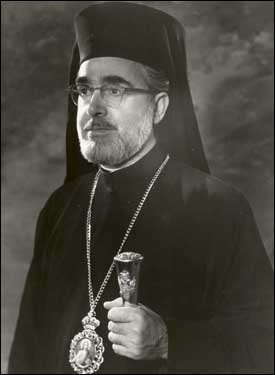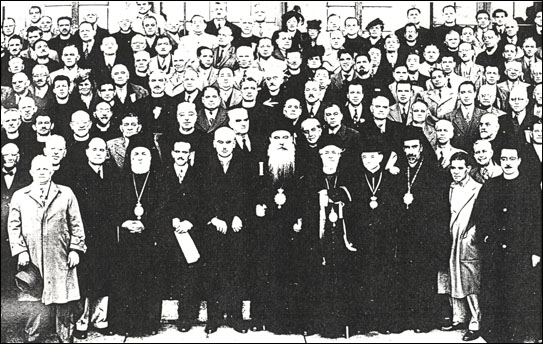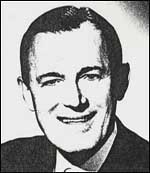
|
|
|||
|
III. 1940- 1960
The Cathedral experienced new problems and challenges during and immediately following World War II. At this critical period in its history, it was fortunate to have Rev. James A. Coucouzes become its Dean. Upon his graduati
Fr. James, pater, or Fr. Jake as he was fondly known by his flock at the Cathedral, organized various war relief efforts including the Greek War Relief, selling War Bonds, and promoting participation in the Red Cross. Servicemen and women were provided prayer books and other religious items, parcels were mailed and special services held. The Cathedral served as the center of life for the Community. The post war era created different ministry demands for the Cathedral. Under Fr. Coucouzes' inspirational leadership, many new programs were organized for the youth and those returning from the service. A Cathedral Youth Organization was revitalized which eventually led to the formation, on a national level, of GOYA - the Greek Orthodox Youth of America. Sunday School became a model for many Greek Orthodox churches. A Sunday Evening Vesper Program was instituted for youth in the Boston area and for Orthodox students attending area colleges and universities. The Program of prayer and worship, fellowship, and discussions of various religious issues, provided spiritual and intellectual stimulation for a generation of young people. The Program developed into the formation of an Orthodox Christian Fellowship for Orthodox students enrolled in area colleges and universities. In 1943 the Connick Studios were commissioned to design the stain glass windows in the narthex, sacristy, and stair landings. Windows and two large canvas paintings for the downstairs chapel and Sunday School rooms were done in 1954 by Wilbur H. Burnham. Additional wall paintings completing the iconography in the apse and on the sides of the iconostasis were done in 1973 by inconographer George Philippakis. Art critics consider the Cathedral's interior decorations to be an artistic treasure of Boston. Among other improvements made to the Cathedral during this period were the installation of a marble altar (1944), a large bell (1946), the creation of a separate baptistry to accommodate the increase in baptisms (1947), a complete redecoration of the Cathedral interior (1950), and the installation of a specially designed Aeolian Skinner pipe organ (1951). Concern over dwindling church attendance during the warm summer months led to Fr. Coucouzes starting regular services on Saturday mornings at a picturesque Protestant church in Cohasset. This popular practice continued until the establishment of a Greek church in Wollaston in 1960. Fr. Coucouzes strongly believed the Cathedral's future depended on young people involved in its administration. Many promising young people were encouraged to join the Cathedral's Board of Trustees. Under their guidance, increased activities for the youth were instituted including athletic programs and tournaments. In his efforts to improve the quality of education in the Greek Schools that had proliferated in various areas of greater Bqston, Fr. Coucouzes successfully united the independently functioning Schools into the United Greek Schools System under the administrative authority and control of the Cathedral. To accomplish this, Petros Moutevelis, a qualified educator from Greece, and professor at Hellenic College, was appointed as Superintendent of the United Greek Schools in 1951. Mr. Moutevelis introduced imaginative and effective teaching methods until his retirement in 1976. The Greek Schools flourished under his tutelage. Additional Greek Schools were added in Waban (1957), Quincy (1958), Brookline (1962), and Dedham (1964). All the schools were eventually consolidated into a new diversified program at the new Cathedral Educational Center in Brookline under the direction of Flora Vekiarides.
Fr. Coucouzes and the Cathedral were host to many significant events. The Cathedral hosted religious services, officiated by Patriarch Athenegoras, for the 9th Clergy Laity Congress (Nov. 3-7,1946). In attendance for the Cathedral's 50th Anniversary celebration in 1953 were His Eminence Archbishop Michael, Catholic Archbishop Richard J. Cushing, and Episcopal Bishop Dr. Norman B. Nash. In 1954, Fr. Coucouzes initiated annual Greek Orthodox services at the Cathedral of the Pines in Rindge, NH. Archbishop Athenegoras Cavadas paid a visit to the Cathedral in 1955. Fr. Coucouzes' exceptional talents and qualities were recognized by Patriarch Athenegoras. In 1951 he was elevated to bishop preparing him for greater responsibilities in the Church hierarchy. After being ordained Bishop of Melita in 1955, he was assigned to the Patriarch's headquarters at the World Council of Churches in Geneva, Switzerland. In 1958, he was elected Archbishop of North and South America and fulfilled the dreams and expectations of his beloved Cathedral communicants and the faithful throughout America. During Archbishop lakovos' thirty-seven years as spiritual head of the Greek Orthodox Church of North and South America, the Church experienced unprecedented and impressive results and brought an increased sense of identity to its mission. In 1955, following Bishop lakovos' Patriarchal assignment to Geneva, the Rev. George Bacopoulos was appointed acting Dean of the Cathedral. Upon Fr. Bacopoulos selection as Chancellor of the Archdiocese by Archbishop lakovos in 1958, Rev. John C. Zane
Cathedral presidents providing leadership during the 40's and 50's were James Condos, John Zedros, Parisis Georgiou, George Poulos, Speros Stavropoulos, Harry Demeter, Jr., Arthur Hasiotis, John Alevizos, Charles Maliotis, Angelo Bassett, Milton Stamatos, George Toumpouras, George P. Condakes and George Mirageas. Next Page Page 1 2 3 4 |
|||
 |


